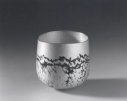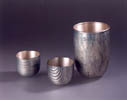|
Born in 1953, Middlesborough, he now lives
and workes in London.
He studied jewellery at Loughborough College of Art, 1972 - 75 and at the Royal College of Art, 1975-78. When experimenting with soldering layers of metal sheets at the RCA in the seventies, he unwittingly rediscovered mokumé gane, a Japanese technique developed 300 years ago and until recently rarely practised anywhere in the world. In 1978 he received a travel grant to visit Japan in order to further his knowledge of the technique and is nowadays recognised as a master of mokumé gane. He is currently a visiting lecturer at Camberwell College of Arts and has exhibited extensively in Britain and the rest of Europe, Japan, Australia and the USA. His work is held in many public collections, including the Victoria and Albert Museum, Leeds City Art Gallery, Birmingham Museums and Art Gallery and the Art Gallery of Western Australia. Alistair about his work : 'For nearly twenty years I have specialised in this Japanese metalworking technique of mokumé gane. This produces wonderful surface patterns which enliven and enrich the simple forms that I use.' In Japan this technique was used for decorating Samurai swords. About a hundred years ago artists began to decorate other objects with it, varying from opiumpipes to vases. Layers of different metals are fused together, mostly alloys of copper, silver and gold, and subsequently parts of the surface are taken away whereby multicoloured patterns are formed. These look like polished woodgrains and from this the technique derived its name mokumé gane ; litterally : "the eye of the woodgrain metal. McCallum uses this technique in a totally new way. His work
is simple in form, and delicate in the decoration and finishing
off. |
|

